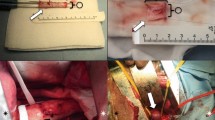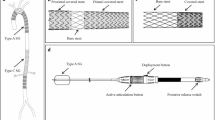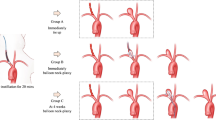Abstract
Purpose
To establish a reproducible porcine model of ascending aortic aneurysm (AsAA).
Methods
We created an AsAA in twelve domestic pigs using a cover-then-cut method, stitching a glutaraldehyde tanned bovine pericardial patch onto the anterolateral aortic wall, then cutting off aortic wall tissue within the patch, and closing the incision in the patch.
Results
The AsAA creation was completed successfully in 11 out of the 12 pigs (91.7%). The mean maximal diameter of the ascending aorta increased significantly by 1.77 times, immediately after the operation (p < 0.05). Significantly continuous expansion of the aneurysm was observed during the follow up period, to 48.9 ± 1.80 mm at 3 months and 50.3 ± 2.25 mm at 6 months (p < 0.05).
Conclusions
This porcine model of AsAA, created using a repeatable cover-then-cut method, represents a reproducible platform for studying and training, which could contribute to the development of new feasible endovascular treatments of AsAAs.




Similar content being viewed by others
Abbreviations
- AsAA:
-
Ascending aortic aneurysm
- CTA:
-
Computed tomography angiography
- TAA:
-
Thoracic aortic aneurysm
References
Barbour JR, Spinale FG, Ikonomidis JS. Proteinase systems and thoracic aortic aneurysm progression. J Surg Res. 2007;139:292–307.
Elefteriades JA. Natural history of thoracic aortic aneurysms: indications for surgery, and surgical versus nonsurgical risks. Ann Thorac Surg. 2002;74:S1877–80 (discussion S1892–8).
Coady MA, Rizzo JA, Goldstein LJ, Elefteriades JA. Natural history, pathogenesis, and etiology of thoracic aortic aneurysms and dissections. Cardiol Clin. 1999;17(615–35):vii.
Chiesa R, Melissano G, Civilini E, de Moura ML, Carozzo A, Zangrillo A. Ten years experience of thoracic and thoracoabdominal aortic aneurysm surgical repair: lessons learned. Ann Vasc Surg. 2004;18:514–20.
Davies RR, Goldstein LJ, Coady MA, Tittle SL, Rizzo JA, Kopf GS, et al. Yearly rupture or dissection rates for thoracic aortic aneurysms: simple prediction based on size. Ann Thorac Surg. 2002;73:17–27 (discussion 27–8).
Fleck TM, Koinig H, Czerny M, Hutschala D, Wolner E, Ehrlich M, et al. Impact of surgical era on outcomes of patients undergoing elective atherosclerotic ascending aortic aneurysm operations. Eur J Cardiothorac Surg. 2004;26:342–7.
Ghansah JN, Murphy JT. Complications of major aortic and lower extremity vascular surgery. Semin Cardiothorac Vasc Anesth. 2004;8:335–61.
Isselbacher EM. Thoracic and abdominal aortic aneurysms. Circulation. 2005;111:816–28.
Kawaharada N, Morishita K, Fukada J, Hachiro Y, Fujisawa Y, Saito T, et al. Stroke in surgery of the arteriosclerotic descending thoracic aortic aneurysms: influence of cross-clamping technique of the aorta. Eur J Cardiothorac Surg. 2005;27:622–5.
Williams JB, Peterson ED, Zhao Y, O’Brien SM, Andersen ND, Miller DC, et al. Contemporary results for proximal aortic replacement in North America. J Am Coll Cardiol. 2012;60(13):1156–62.
Zierer A, Melby SJ, Lubahn JG, Sicard GA, Damiano RJ Jr, Moon MR. Elective surgery for thoracic aortic aneurysms: late functional status and quality of life. Ann Thorac Surg. 2006;82(2):573–8.
Kolvenbach RR, Karmeli R, Pinter LS, Zhu Y, Lin F, Wassiljew S, et al. Endovascular management of ascending aortic pathology. J Vasc Surg. 2011;53:1431–7.
Li Z, Lu Q, Feng R, Zhou J, Zhao Z, Bao J, et al. Outcomes of endovascular repair of ascending aortic dissection in patients unsuitable for direct surgical repair. J Am Coll Cardiol. 2016;68:1944–54.
Muetterties CE, Menon R, Wheatley GH. A systematic review of primary endovascular repair of the ascending aorta. J Vasc Surg. 2018;67:332–42.
Metcalfe MJ, Karthikesalingam A, Black SA, Loftus IM, Morgan R, Thompson MM. The first endovascular repair of an acute type A dissection using an endograft designed for the ascending aorta. J Vasc Surg. 2012;55:220–2.
Li T, Bao X, Feng J, Li Z, Liu J, Zhao Y, et al. Endovascular reconstruction from aortic valve to aortic arch using one-piece valved-fenestrated stent graft with a branch: a proof-of-concept study. Heart Surg Forum. 2019;22(5):E380–4.
Tsilimparis N, Debus ES, Oderich GS, Haulon S, Terp KA, Roeder B, et al. International experience with endovascular therapy of the ascending aorta with a dedicated endograft. J Vasc Surg. 2016;63:1476–82.
Rohlffs F, Tsilimparis N, Detter C, von Kodolitsch Y, Debus S, Kölbel T. New advances in endovascular therapy: endovascular repair of a chronic debakey type II aortic dissection with a scalloped stent-graft designed for the ascending aorta. J Endovasc Ther. 2016;23:182–5.
Abel DB, Beebe HG, Dedashtian MM, Morton MC, Moynahan M, Smith LJ, et al. Preclinical testing for aortic endovascular grafts: results of a food and drug administration workshop. J Vasc Surg. 2002;35:1022–8.
Feng J, Bao X, Li T, Zhao Y, Mingwei Wu, Liu J, et al. Endovascular reconstruction from aortic valve to aortic arch using 1-piece valved fenestrated bifurcated endografting. J Am Coll Cardiol. 2020;75(16):2090–2.
Khoynezhad A, Donayre CE, Walot I, Koopmann MC, Kopchok GE, White RA. Feasibility of endovascular repair of ascending aortic pathologies as part of an FDA-approved physician-sponsored investigational device exemption. J Vasc Surg. 2016;63:1483–95.
Wipper S, Lohrenz C, Ahlbrecht O, Carpenter SW, Tsilimparis N, Kersten JF, et al. Transcardiac endograft delivery for endovascular treatment of the ascending aorta: a feasibility study in pigs. J Endovasc Ther. 2015;22:375–84.
Eggebrecht H, Kahlert P, Kaiser GM, McDougall I, Sarrat-Cave Z, Herrmann RA, et al. Technical development and initial animal experience with a novel, uncovered, self-expanding, highly flexible aortic stent with improved side branch access. J Endovasc Ther. 2009;16:539–45.
Yang J, Liu Y, Duan W, Yi D, Yu S, Ma R, et al. A feasibility study of total endovascular aortic arch replacement: from stent-graft design to preclinical testing. J Thorac Cardiovasc Surg. 2016;151:1203–12.
Eckhouse SR, Logdon CB, Oelsen JM, Patel RK, Rice AD, Stroud RE, et al. Reproducible porcine model of thoracic aortic aneurysm. Circulation. 2013;128:S186–93.
Li W, Xu K, Ni Y, Zhong H, Bi Y. A canine model of proximal descending thoracic aortic aneurysm created with an autologous pericardial patch. Ann Thoracic Cardiovasc Surg. 2013;19:131–5.
Hope MD, Hope TA, Crook SE, Ordovas KG, Urbania TH, Alley MT, et al. 4D flow CMR in assessment of valve-related ascending aortic disease. JACC Cardiovasc Imaging. 2011;4(7):781–7.
Kari FA, Kocher N, Beyersdorf F, Tscheuschler A, Meffert P, Rylski B, et al. Four-dimensional magnetic resonance imaging-derived ascending aortic flow eccentricity and flow compression are linked to aneurysm morphology. Interact Cardiovasc Thorac Surg. 2015;20(5):582–7.
Bürk J, Blanke P, Stankovic Z, Barker A, Russe M, Geiger J, et al. Evaluation of 3D blood flow patterns and wall shear stress in the normal and dilated thoracic aorta using flow-sensitive 4D CMR. J Cardiovasc Magn Reson. 2012;14(1):84.
Gülan U, Calen C, Duru F, Holzner M. Blood flow patterns and pressure loss in the ascending aorta: a comparative study on physiological and aneurysmal conditions. J Biomech. 2018;25(76):152–9.
Remi E, Khelil N, Di Centa I, Roques C, Ba M, Medjahed-Hamidi F, et al. Pericardial processing: challenges, outcomes and future prospects. In: Biomaterials science and engineering, InTech Pub. 2011; pp 437–456.
Ruiz CE, Butt AI, Zhang HP. Spontaneous rupture and thrombotic effects in a swine model of untreated abdominal aortic aneurysms. J Thromb Thrombolysis. 1996;3:189–94.
Maynar M, Qian Z, Hernandez J, Sun F, DeMiguel C, Crisostomo V, et al. An animal model of abdominal aortic aneurysm created with peritoneal patch: technique and initial results. Cardiovasc Intervent Radiol. 2003;26:168–76.
Acknowledgements
The study was conceived by Jian Zhou, Jiaxuan Feng and Zaiping Jing. Analysis was by Zhenjiang Li. The manuscript was drafted by Zhenjiang Li, Junjun Liu, and Rui Feng. All authors contributed to analysis and interpretation of the data and critical revision of the manuscript.
Funding
Supported by the National Natural Science Foundation of China (Grant nos. 81770476, 81870366, 91739110, 81970208, 82000430), the Foundation of Shanghai Science and Technology Commission (Grant no. 16411966400), and the Shanghai Science and Technology Support Project (Grant no. 17441901900).
Author information
Authors and Affiliations
Contributions
Conception and design: JF, JZ, ZJ. Analysis and interpretation of data: ZL, JL, RF, JF, XB, FQ. Writing the article: ZL, JL, RF. Critical revision of the article: JF, JZ, RF, ZJ. Statistical analysis: ZL, TL. Obtained funding: JF, JZ, ZJ. ZL, JL, and RF participated equally and share equal authorship.
Corresponding authors
Ethics declarations
Conflict of interest
We have no conflicts of interest to declare.
Research involving human/animal participation
No human studies were carried out by the authors in relation to this article.
Ethical approval
All institutional and national guidelines for the care and use of laboratory animals were followed and approval was given by the appropriate institutional committees.
Additional information
Publisher's Note
Springer Nature remains neutral with regard to jurisdictional claims in published maps and institutional affiliations.
Rights and permissions
About this article
Cite this article
Li, Z., Liu, J., Feng, R. et al. A new porcine model of ascending aortic aneurysm established using a cover-then-cut method. Surg Today 51, 906–915 (2021). https://doi.org/10.1007/s00595-020-02198-x
Received:
Accepted:
Published:
Issue Date:
DOI: https://doi.org/10.1007/s00595-020-02198-x




